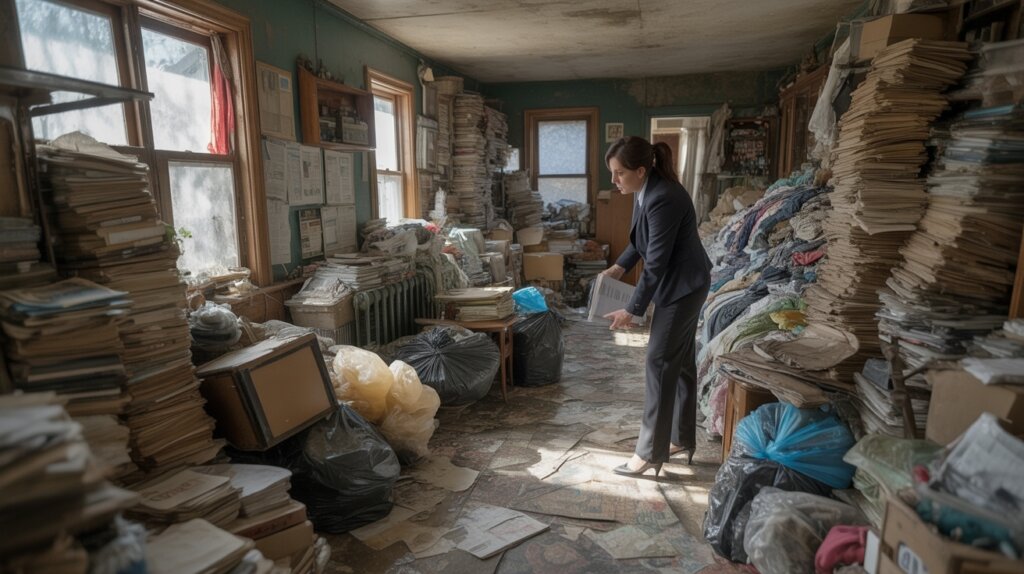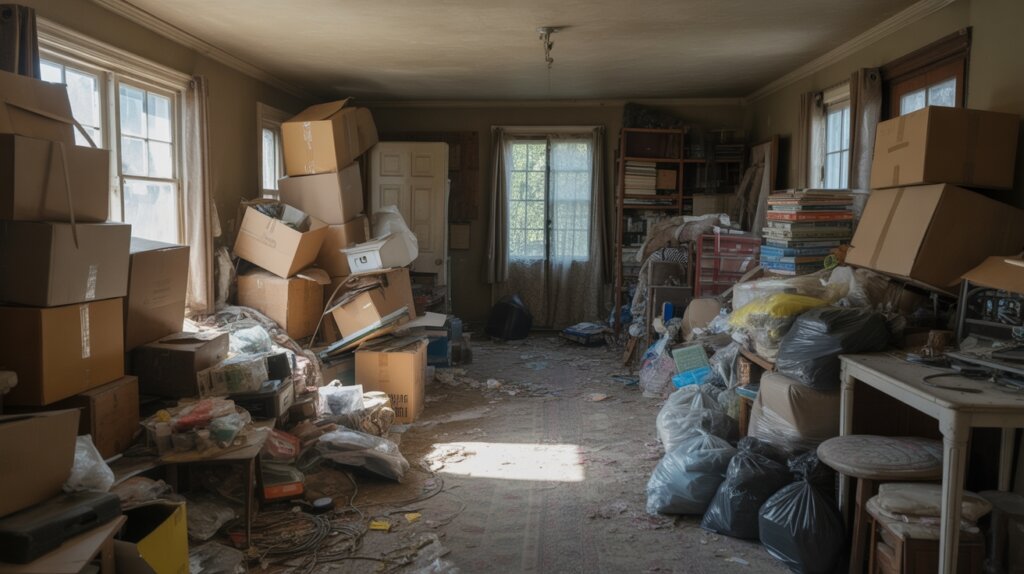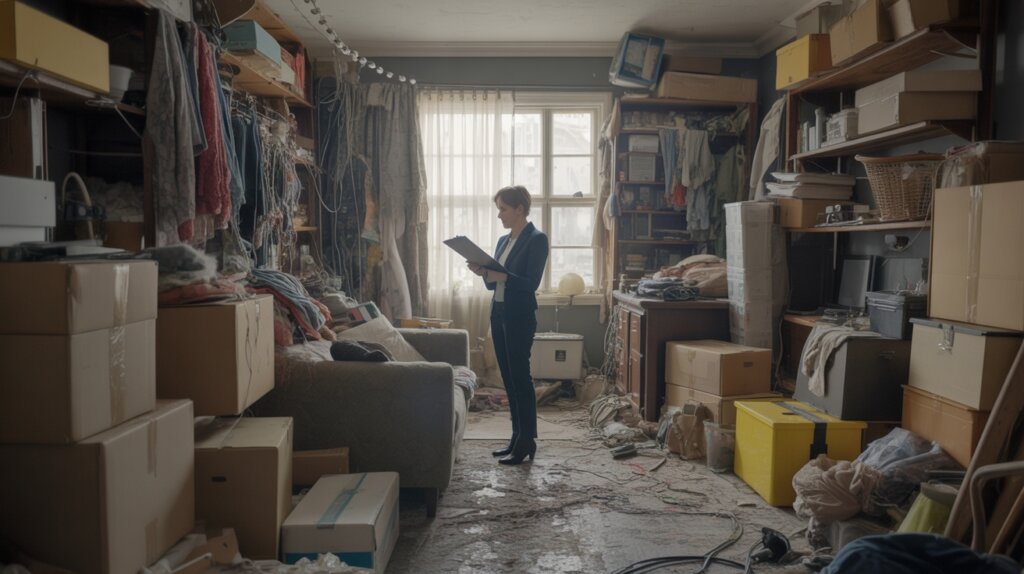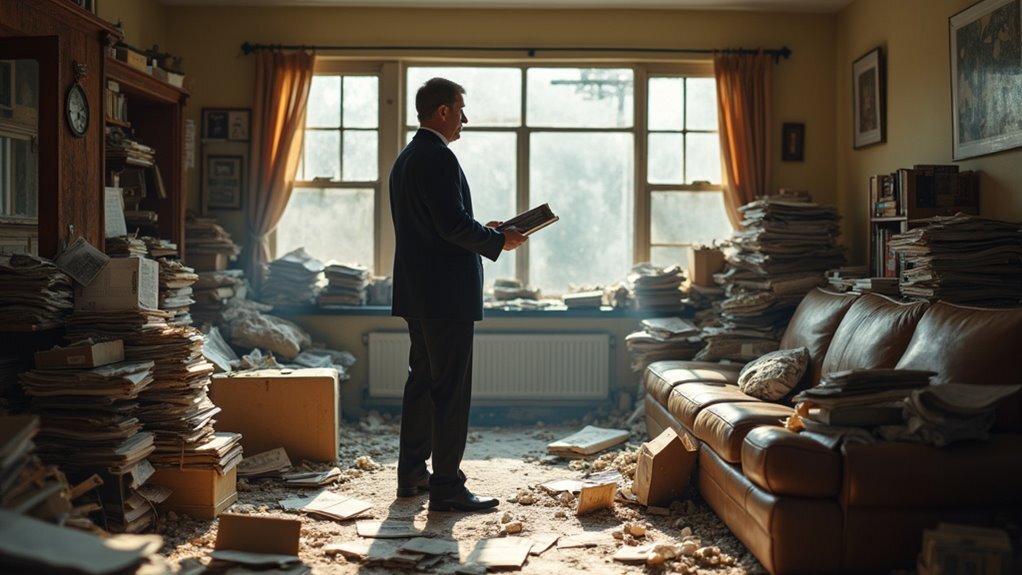Selling a hoarder house is not like selling a regular home. Piles of clutter and possible hidden damage make it a tough challenge. Many sellers feel lost and unsure how to start.
These homes scare away traditional buyers and lower your property value. The cost and effort to clean up can seem overwhelming. This stress often leads to delays and missed opportunities.
However, you can overcome these problems with the right approach and some practical knowledge. Yes, you can sell a hoarder house if you know what steps to take.
Simple strategies can help you turn problems into profits. This blog will guide you through every step needed to sell a hoarder house with confidence and success.
Key Takeaways
- Hoarder homes often hide safety hazards and structural damage, requiring professional inspections and repairs to ensure buyer confidence and compliance with local regulations.
- Persistent odors and pest infestations can deter buyers; use professional cleaning and pest control services and document all remediation efforts.
- Pricing is challenging due to extra cleanup and repair costs; consult experienced agents and adjust expectations based on local market data.
- Deciding between cleaning or selling as-is impacts your timeline and profit—cleaning attracts more buyers, but investors may prefer as-is deals.
- Effective marketing should highlight the property’s investment potential and target niche buyers like investors, flippers, and bargain seekers.
Identifying the Scope of the Hoarding Problem

To identify the scope of a hoarding problem, first check every room and note the amount of clutter. Take photos and write notes to show which areas need the most work. If you do this, you will have a clear picture of the house’s condition.
Clutter should be sorted by type and importance. This step helps you understand what items are valuable or just taking up space. If the house has many personal items, removing them may take more time.
Hoarding often involves strong emotional attachment to objects. This can make cleaning and staging harder. If the owner struggles to let things go, plan extra time for this step.
Buyers and investors want honest details about the property’s challenges. Document your findings so you can explain any issues clearly. If you do this well, you can set realistic expectations for time and cost.
Addressing Health and Safety Hazards
Hoarder houses often hide many health and safety hazards. You must fix these issues before listing the property for sale. Common problems include mold, biohazards, structural damage, and fire risks.
A full inspection can find these dangers. Professionals should handle cleaning and sanitation tasks. This process makes the home safer and meets legal requirements.
If you skip pest control, infestations may lower your home’s value. Extermination services can solve pest problems and provide official records. Buyers feel more confident when safety issues are addressed.
A safe, clean home attracts more buyers. Proper documentation shows your commitment to safety. If you resolve hazards early, you will have a smoother sale.
Additionally, understanding the impact of damage on market value can help prioritize repairs and justify your pricing during negotiations. Conducting a professional assessment can also ensure that hidden mold or other hazards are identified and remediated properly.
Navigating Emotional and Psychological Barriers

Emotional and psychological barriers can be harder than practical challenges when selling a hoarder house. These feelings may slow down the process or make decisions difficult. Understanding and facing these emotions early can help you move forward.
Many people feel overwhelmed by the amount of belongings and memories. If you find it hard to let go, focus on your main goal of selling the house. Remind yourself that keeping every item is not necessary.
You might experience guilt or embarrassment during this process. If these feelings appear, remember the future benefits, like financial relief or a fresh start. Seeking help from friends, family, or professionals can make the process easier. If guilt or embarrassment arises, focus on future benefits and reach out for support to make the process easier.
Additionally, recognizing the property’s market value and potential can motivate you to overcome emotional obstacles and see the bigger picture. If you stay focused on your end goal, you will likely navigate this phase more effectively. Approaching each step calmly and logically can help reduce anxiety and increase clarity during decision-making. With support and a clear plan, you can overcome these barriers.
Dealing With Structural Damage and Repairs
To sell a hoarder house, you must address structural damage and needed repairs first. This step helps increase your property’s value and attracts buyers. Ignoring damage can lower your selling price.
A full damage check helps find hidden problems like weak floors or cracked walls. Qualified inspectors or contractors should do this assessment. If you find major issues, fix them before listing the house. Early assessment of foundation issues is crucial to prevent costly future repairs and ensure safety.
You should focus on repairs that bring the best return for your money. If a repair is not urgent, you can choose to disclose it to buyers. Always keep records of all repairs to build trust with buyers.
If you take these steps, your house will have a better chance in the market. Buyers are more likely to consider a property with clear repair history. Proper repairs also help you support your asking price.
Managing Odors and Pest Infestations
You’ll need to pinpoint stubborn odors and infestation hotspots quickly, as they can deter serious buyers and complicate inspections. Tackle these issues head-on with targeted cleaning and professional pest control to protect your property’s value.
By using proven preventative strategies, you’ll create a healthier environment and boost your home’s market appeal. Additionally, conducting a comprehensive property inspection can help identify underlying issues early, making it easier to address problems before they impact the sale.
Identifying Persistent Source Odors
Odors often remain after cleaning, so finding their source is important before selling a hoarder house. Bad smells can drive buyers away and lower the home’s value. If you want to sell, you must find where the odors come from.
Start by checking each room for wet spots, pet messes, or rotten items. Look under carpets, behind appliances, and inside vents if you do not find the source right away. These hidden places often hold smells that regular cleaning misses.
Call an odor detection expert if you still cannot find the cause. Professionals use special tools to find hidden moisture or stains. Their help can make the house ready for buyers.
Addressing Infestation Hotspots
Infestation hotspots are common in hoarder homes and need attention to improve cleanliness and value. These are places where pests like mice, cockroaches, or bedbugs hide and breed. If you do not address these areas, the house will stay unattractive to buyers.
You should inspect kitchens, basements, and spaces behind large piles for signs of pests. A professional pest control service can check the home and suggest the best treatments. If you act quickly, you can limit damage and boost buyer confidence.
Being honest about recent pest control actions builds trust with buyers. Properly treated homes are more appealing and easier to sell. If you remove pests at their source, you help restore the home’s value.
Preventative Cleaning Techniques
Preventative cleaning techniques help stop new odors and pests before they appear. These methods keep your space pleasant and protect property value. If you clean regularly, you can avoid many future problems.
A weekly clutter check removes items that attract pests or cause bad smells. If you keep areas tidy, pests have fewer places to hide. You should throw away anything you do not need.
Moisture control is important for a healthy home. If you use dehumidifiers or open windows, you lower the risk of mold and bugs. Air flow keeps rooms fresh and dry.
A cleaning schedule helps keep surfaces and floors free from dirt. If you vacuum and wipe hidden spots, you block buildup and infestations. Routine care is key to long-term cleanliness.
Complying With Local Codes and Regulations

Complying with local codes and regulations is essential when selling a hoarder house. Municipalities require homes to meet safety and health standards. If these rules are ignored, you may face penalties or delays. Meeting local codes and safety standards is crucial when selling a hoarder house to avoid penalties and delays.
Hoarder homes often hide problems like mold or pests. These issues can violate local ordinances. You must address them before you sell the property.
Contact your local code enforcement office to learn about needed repairs. If you find hazards, hire certified experts to fix them. Always keep records of repairs and inspections for future buyers.
Additionally, working with experienced cash buyers like Greg Buys Houses can help navigate local regulations more smoothly, ensuring your sale complies with all requirements. Understanding property liens and resolving any outstanding issues early can prevent delays during closing.
If the home has zoning issues, get the required permits or variances. Schedule inspections to catch any safety violations early. Proper documentation will help you avoid legal trouble later.
Determining the True Value of the Property
To find the true value of a hoarder house, do not rely only on standard price comparisons. You must consider the extra costs and problems these homes have. A hoarder house often needs more repairs and cleaning than a typical home.
A home inspection is the first step if you want a clear picture of repair needs and safety risks. The inspection might reveal hidden damage not seen at first glance. If major problems exist, repair costs will be higher.
Market value should be adjusted if the home is in poor condition. You can compare your house to similar homes, but factor in the hoarding impact. Local sales can help you set a realistic price if you use the right adjustments.
A real estate agent with experience in distressed properties can offer valuable advice. If you are unsure about the price, ask for professional help. An expert can guide you on the best steps to take.
Additionally, understanding the local real estate market can help you set a more accurate price and develop a strategy to sell the property efficiently.
Deciding Between Cleaning or Selling As-Is
When you’re weighing whether to clean out or sell as-is, start by comparing the cleanup costs and timeline against your expected return. Consider what local buyers want—some may pay more for move-in ready, while investors might prefer a project. Your decision directly affects both the sale price and how quickly you can close the deal.
Additionally, understanding property condition and disclosure requirements can help you make an informed choice that aligns with your financial and emotional goals. Evaluating legal disclosures and ensuring proper documentation can also influence how smoothly the sale proceeds.
Cost and Time Analysis
Restoring a hoarder house can require a lot of money and time. You should compare these costs to the possible sale profit. This helps you decide if the effort is worthwhile.
Professional cleaning and repairs usually cost a lot. If the sale price will not cover these costs, you may want to reconsider. The time spent fixing the house also delays your sale.
You will pay for taxes, insurance, and utilities while you work on the house. These holding costs can add up quickly. If the process takes too long, your net profit may shrink.
If you sell the house “as-is,” you may get less money, but the sale will be faster. Sometimes, a quick sale saves you more in the long run. Always compare both options before deciding.
Buyer Expectations Considered
Buyers expect honest information about a hoarder house’s condition. Most do not look for luxury finishes or new updates. They want to know what repairs or cleaning the home needs.
Some buyers, like investors, prefer to buy homes as-is. These buyers plan to fix or upgrade the property themselves. Others may leave if the house seems too difficult to clean or repair.
If you clean the house, focus on safety and basic cleanliness. High-end features are less important than a safe, livable space. Your target market could be bargain hunters or people wanting a move-in ready home.
If you know what buyers expect, you can make better decisions about cleaning or repairs. Buyer expectations should help guide your next step. Cost and time are not the only factors to consider.
Impact on Sale Price
Cleaning or selling a hoarder house as-is will affect its sale price. A clean home usually attracts higher offers from buyers. Selling as-is often leads to lower offers because buyers expect to pay for cleaning.
If you clean the house thoroughly, you may see a better sale price. This option takes more time and effort but can increase buyer interest. Traditional buyers are more likely to consider a home that looks well kept.
Selling as-is saves you time and upfront costs. Investors or flippers may buy the home, but their offers will be lower. They will factor in the costs of cleaning and repairs.
A hybrid approach is possible if a full cleaning feels overwhelming. You can focus on the worst areas to improve the home’s look. This option can balance your costs with a better sale price.
If you are unsure, check local market trends and your own priorities. Each choice has benefits and drawbacks. Consider what matters most to you before making a decision.
Attracting the Right Buyers
Hoarder houses do not attract most homebuyers. If you want to sell, you should target investors, flippers, or bargain hunters. These buyers look for properties with low prices or renovation potential.
You can highlight the home’s value by mentioning its price and room for improvement. Minimal cleaning, like clearing walkways, can help buyers imagine the space. If you show important features, buyers may see the property’s full potential. Additionally, understanding home damage assessment can help you better present the property’s condition to interested buyers. Knowing how to sell your house as-is allows you to avoid costly repairs and streamline the selling process.
Social media is a useful tool for reaching these buyers. You could post in investor groups or real estate forums to get attention. If you market the property to the right audience, you are more likely to sell quickly and at a fair price.
Marketing Strategies for Difficult Properties
You’ll get better results by positioning the property as an investment opportunity and showcasing its untapped value. Focus your marketing on buyers who specialize in renovations or are seeking fixer-uppers. By targeting these niche groups, you attract those most likely to see past the challenges and recognize the powerful potential.
Highlighting the simplified process and transparency in transactions can also appeal to cash buyers looking for a straightforward, no-hidden-fee deal. Emphasizing the as-is condition and the benefits of quick sales can further attract investors eager for opportunities that require minimal initial investment.
Highlighting Investment Potential
A hoarder house can be a smart investment if marketed for its future potential. Buyers are often interested in homes they can improve for a profit. If you focus on the property’s possible value, you will attract serious investors.
You should compare similar renovated homes in the area. If you share higher sale prices of these homes, buyers can see the potential. This information helps buyers understand the value they could unlock.
Estimate the return on investment for upgrades like storage and clutter removal. If you give clear numbers, buyers can decide if the effort is worthwhile. This makes the property more appealing.
Show buyers the home’s layout once cleared of clutter. If you highlight open spaces and extra rooms, the possibilities become obvious. Buyers can then picture the home’s full potential.
Targeting Niche Buyer Groups
You can sell hoarder homes by focusing on buyers who see value in these properties. Investors, flippers, and bargain hunters often look for such deals. They want homes at low prices with potential for profit.
Highlight cost savings and the chance to fix up the property. You should mention cleaning options and professional services that make improvements possible. This helps buyers see that the home can be transformed.
If you target buyers with experience in emotional support, like social workers, you may find more interest. Nonprofits might also want homes for special projects. Use online platforms designed for these groups to reach them quickly.
Tailor your message to each group’s needs and interests. Clear communication can speed up the sale and solve common challenges. If you focus on the right audience, selling a hoarder home becomes easier.
Working With Real Estate Professionals
Partnering with the right real estate professional makes selling a hoarder house much easier. An experienced agent knows the local market and has helpful resources. This support can save you time and reduce stress.
A professional agent will assess your home and suggest affordable changes to attract buyers. The agent can recommend cleaners, contractors, or designers if your home needs extra help. These connections improve your home’s appearance and value.
Agents use strong marketing skills to reach interested buyers. They create attractive listings with professional photos and clear descriptions. If you work with an agent, your house may sell faster and for a better price.
Negotiating Offers and Disclosures
You’ll need to approach property disclosures with complete transparency, as buyers expect honesty about a hoarder house’s condition. Be prepared for lowball offers and have a clear strategy to counter them without losing serious buyers. By anticipating these challenges, you’ll protect your interests and keep negotiations on track.
Handling Required Property Disclosures
When selling a hoarder house, you must share all required property information with buyers. Disclose any problems that could affect the sale, like structural or safety issues. Honest disclosures help prevent problems with buyer loans and insurance.
Sellers should list all known issues, such as mold or pests, in writing. If possible, they can hire inspectors to find any hidden damage. These steps make the disclosure clear and trustworthy.
Buyers may ask questions about repairs or cleanup. Sellers should explain what has been done or what still needs fixing. This builds trust and helps the sale go smoothly.
Navigating Lowball Offer Strategies
Clear disclosures help buyers and sellers start negotiations. Buyers may use these details to offer a much lower price. Sellers should expect this and prepare.
Sellers can remove junk and declutter before listing the house. This shows buyers the home’s true potential and reduces their leverage. If buyers see a clean space, they may offer a fairer price.
Sellers can use before-and-after photos to highlight improvements. Comparable sales of similar clean homes can support the asking price. If buyers push for a low offer, sellers should use these facts to counter.
If buyers demand a big discount, sellers can suggest repairing key issues instead of lowering the price. Taking the lead and knowing the market earns respect. This approach can help sellers get a better deal.
Handling Legal and Financial Complications
Hoarder houses can create legal and financial problems during a sale. Sellers may face issues like disclosure rules, code violations, and unpaid bills. It is important to handle these problems before listing the property.
Owners should check the property title and resolve any liens early. Unresolved ownership or lien issues can delay or block a sale. Selling as-is requires full honesty about the home’s condition. If sellers hide problems, they could face legal trouble later.
Sellers must also check for unpaid taxes, fees, or fines. If these exist, they should include them in the selling price or negotiation. Careful planning can help avoid last-minute complications.
Leveraging Cash Buyers and Investors
Selling a hoarder house is easier with cash buyers and investors. These buyers do not mind the current condition of the property. They focus on the potential value instead of how the home looks now. Cash buyers and investors overlook mess and repairs, focusing on potential rather than the current condition of a hoarder house.
Cash buyers and investors move quickly. Most sales close in less than 30 days. If you need a fast sale, this is a good option.
Repairs are rarely needed with this type of sale. Investors expect to handle any cleaning or decluttering. You do not have to fix every problem before selling.
If you want to avoid delays, consider reaching out to these buyers. This method reduces stress and skips the usual complications. Emotional attachment should be set aside to see your house as an asset.
Conclusion
If you need to sell a hoarder house, you may face some unique challenges. If you work with experienced professionals and prepare carefully, you can achieve a successful sale. If you understand the process, you will feel more confident in your decisions.
If you want a faster and easier solution, we buy houses for cash in any condition. We can help you avoid the hassle of cleaning, repairs, and showings. If you prefer a simple sale, this option may work best for you.
If you are ready to move forward, let OC Real Estate guide you through your options. We are here to support you every step of the way. Contact us today to see how we can help you sell your hoarder house quickly.

